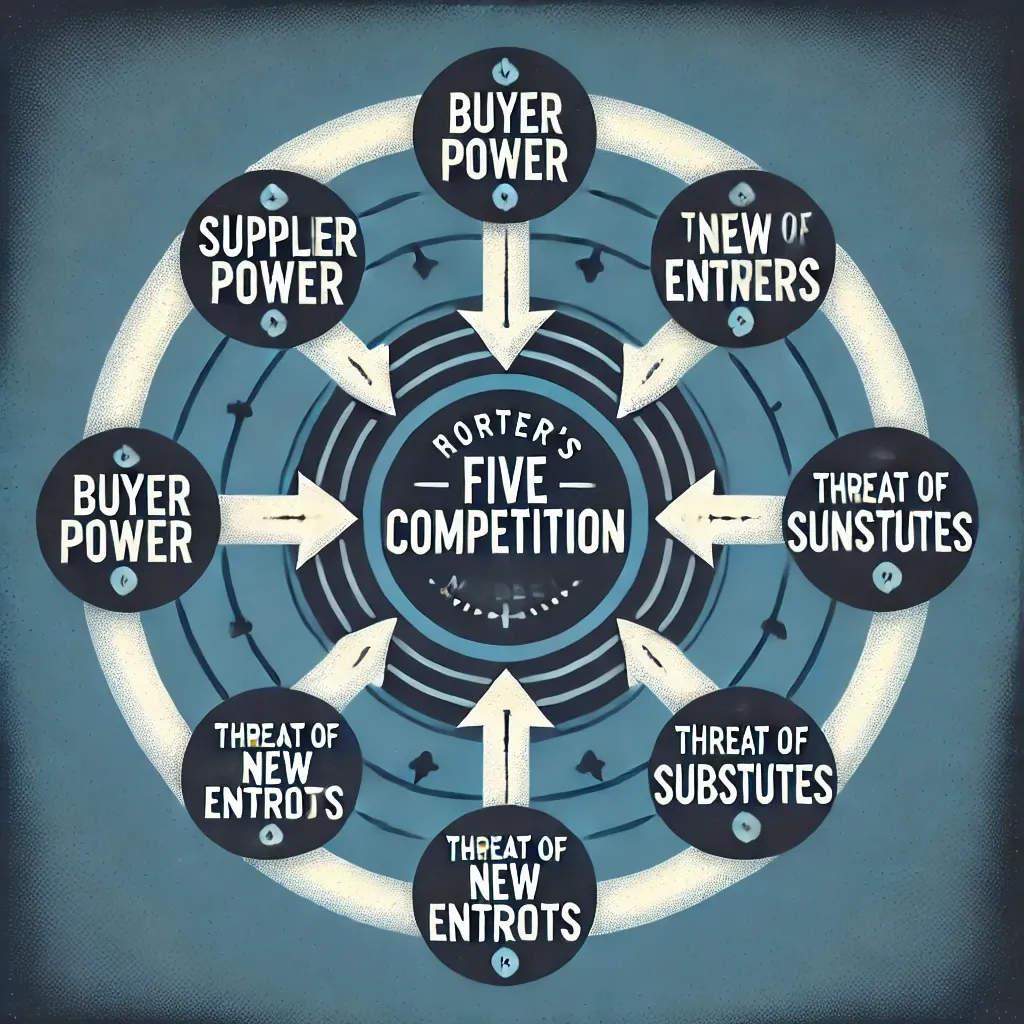Porter 5 Forces

In today’s competitive business landscape, understanding market dynamics and devising effective strategies are crucial for sustained success. One of the most widely recognized tools for analyzing competition and market structure is Porter’s 5 Forces framework. Developed by Harvard Business School professor Michael Porter, this model helps businesses evaluate their industry’s competitive forces and craft strategies to gain a competitive edge.
This article explores each of the five forces in detail and provides actionable strategies to navigate them.
The 5 Forces Framework
1. Competitive Rivalry
Competitive rivalry assesses the intensity of competition within an industry. High rivalry can limit profitability, while low rivalry can create opportunities for growth.
Key Questions:
- How many competitors are there?
- What is the quality and differentiation of their products or services?
- What is the market’s growth potential?
Strategies to Address Competitive Rivalry:
- Differentiate Your Offerings: Highlight unique features or superior quality.
- Focus on Cost Efficiency: Streamline operations to offer competitive pricing.
- Invest in Branding: Build strong brand recognition and customer loyalty.
Example: In the fast-food industry, McDonald’s competes with global giants like KFC and local players. It maintains its competitive edge by leveraging strong branding, localized menus, and efficient supply chains.
2. Bargaining Power of Suppliers
Suppliers’ power determines their influence on the cost and availability of inputs. When suppliers are concentrated or offer unique products, they hold significant leverage.
Key Factors:
- Number of suppliers
- Uniqueness of inputs
- Cost of switching suppliers
Strategies to Mitigate Supplier Power:
- Diversify Suppliers: Avoid over-reliance on a single supplier.
- Negotiate Long-Term Contracts: Secure favorable terms.
- Develop In-House Capabilities: Where feasible, produce key inputs internally.
Example: McDonald’s reduces supplier dependency by working with a wide network of suppliers and maintaining stringent quality control processes.
3. Bargaining Power of Buyers
Buyers’ power reflects their ability to influence pricing and demand better quality or service. Strong buyer power can erode profitability.
Key Factors:
- Availability of alternatives
- Price sensitivity
- Purchase volume
Strategies to Reduce Buyer Power:
- Enhance Value Proposition: Offer additional features or services.
- Build Customer Loyalty: Implement rewards programs and personalized experiences.
- Differentiate Products: Create unique offerings to reduce price sensitivity.
Example: Fast-food customers have many options. McDonald’s builds loyalty through consistent quality, localized menus, and affordability.
4. Threat of New Entrants
The ease with which new competitors can enter an industry impacts market dynamics. High barriers to entry discourage potential entrants, while low barriers increase competition.
Key Barriers to Entry:
- Economies of scale
- Brand loyalty
- Capital requirements
- Regulatory compliance
Strategies to Raise Barriers:
- Invest in Innovation: Stay ahead of industry trends.
- Strengthen Brand Identity: Make it harder for newcomers to capture market share.
- Achieve Operational Excellence: Enhance efficiency and cost leadership.
Example: McDonald’s leverages its strong brand and established franchise model to create significant barriers for new entrants in the fast-food market.
5. Threat of Substitutes
Substitutes pose a risk when customers can easily switch to alternative products or services. The availability of substitutes can cap prices and limit profitability.
Key Factors:
- Availability of substitutes
- Price-performance trade-off
- Switching costs
Strategies to Combat Substitution:
- Diversify Product Offerings: Cater to varying customer preferences.
- Emphasize Differentiation: Highlight unique features and benefits.
- Enhance Customer Experience: Build strong relationships to reduce switching.
Example: In the beverage industry, companies counter the threat of substitutes like flavored water and juices by diversifying their portfolios and introducing healthier options.
Applying Porter’s 5 Forces: Strategic Insights
Porter’s 5 Forces model is a dynamic tool that helps businesses:
- Understand Industry Structure: Identify opportunities and threats.
- Develop Competitive Strategies: Align resources to address each force effectively.
- Drive Innovation: Anticipate market changes and adapt proactively.
By regularly applying this framework, organizations can make informed decisions, strengthen their market position, and achieve long-term profitability.

